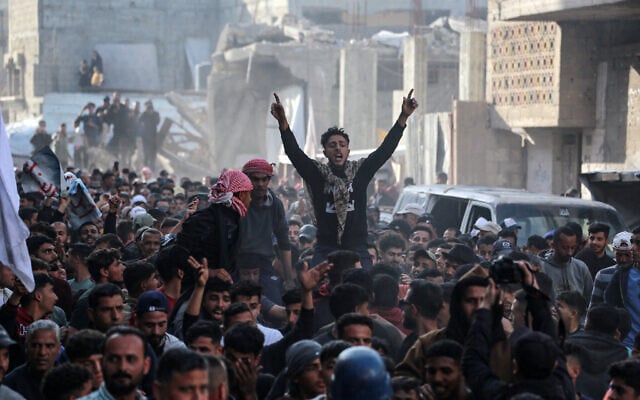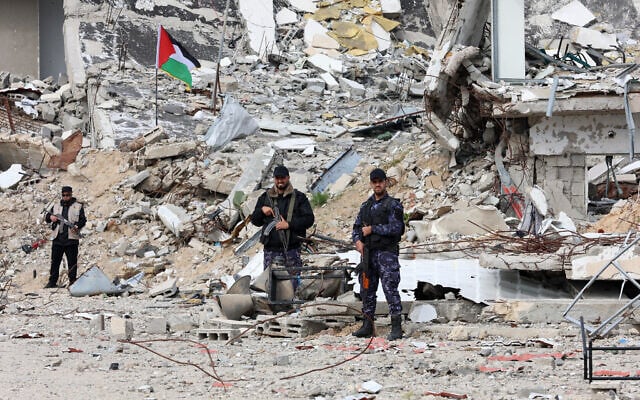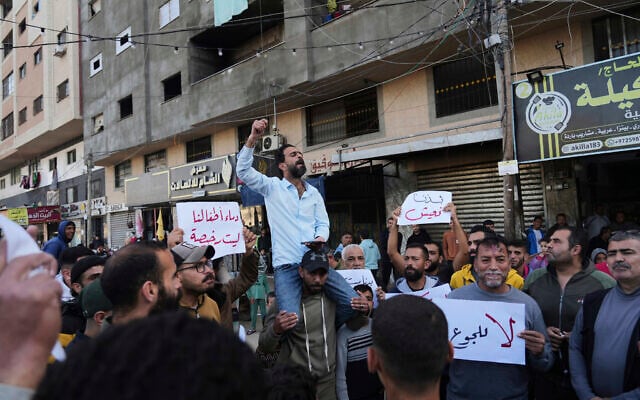



Gazan journalists face beatings and threats while covering anti-Hamas protests and dissent in the Strip, forcing them to self-censor to ensure their safety, the Committee to Protect Journalists reported Thursday.
The media watchdog lamented that the phenomenon has been “vastly underreported,” noting that the Palestinian Journalists’ Syndicate, the Palestinian journalists’ union, does not publicize the testimonies they compile of Hamas attacks on reporters over fear of reprisals.
Gazan Tawfiq Abu Jarad told CPJ that he complied with a Hamas security agent’s warning not to cover a women’s anti-war protest on April 27 in Beit Lahiya, adding that the agent told him he would be “responsible” if his wife took part in the rally.
Jarad recounted that he was beaten and questioned in November 2023 by Hamas operatives in Rafah, who alleged he was “covering events in the Gaza Strip calling for a coup.”
“I have not covered any recent demonstrations,” said Abu Jarad, who works for the Ramallah-based Sawt al-Hurriya radio station.
The reporter filed a complaint to PJS over the intimidation, which slammed Hamas’s infringement on press freedom.
Since late March, sporadic protests against the terror group, which has been the de facto government of Gaza for almost two decades, have taken place in the Strip, despite reports of Hamas attempting to detain and harm demonstrators, and counter to claims by the terror group that the protests are merely anti-war. Many of the protests have occurred in Beit Lahiya.
Before the war, anti-Hamas protests were also relatively rare events, and were often suppressed violently by the terror group.
CPJ said the journalists’ union, limited by the hesitancy of Gaza journalists to speak up publicly, only published the testimony of one other Gaza journalist, Ibrahim Muhareb, who was brutally assaulted last year by men claiming to be plain-clothed Hamas policemen.
Muhareb, a freelance photographer who was working from a tent outside Nasser Hospital in Khan Younis, said he was set upon by agents and suffered deep head wounds in the attack.
“When I tried to contact a police officer in charge of journalists’ affairs, they tried to dismantle my tent. When I resisted, they began assaulting me, by kicking me,” he said.
“I tried to speak to them calmly, but they began to beat me even more severely. They suddenly struck me with an instrument, causing me to lose consciousness, and blood flowed from my head,” he added. “Some colleagues tried to intervene, but they prevented them, literally telling them that ‘the spy and the journalist are one and the same.'”
Muharab said that other journalists eventually managed to pull him away and took him to receive medical attention.
Mohammed Abu Aoun, a correspondent for Fatah-linked Awda TV, told CPJ he was set on by Hamas security agents in 2024 while interviewing a woman in Deir al-Balah who began insulting Hamas’s leaders.
“The officers immediately took me to an unknown location and beat me,” he told the watchdog.
CPJ cited several other journalists who were prevented from covering certain events, but did not consent to their stories going public.
Ismail Al-Thawabta, the director general of Gaza’s Hamas-run Government Media Office, claimed to have received no complaints over intimidation regarding media coverage of the rallies, or any such measures from security agents in response to CPJ’s queries.
Thawabta also claimed that Hamas has “fully opened the field” and ensured journalists could safely and freely cover events in Gaza.
PJS’ head Nasser Abu Bakr told the committee that Hamas’s regime commits “major violations” against press freedoms, including “summonses, interrogations, phone calls, threats, sometimes beatings and arrests, to harassment, publication bans, interference with content, and surveillance.”
Deputy PJS head Tahseen al-Astal said that journalists do not want to go public about their problems, feeling such stories would “pivot eyes from the war in Gaza.”
“Most journalists have begun to practice self-censorship in their writing to avoid any problems with security,” he added.
CPJ Regional Director Sara Qudah expressed alarm over the “threats, assaults and intimidation” experienced by Gazan journalists.
“Hamas must end its repression of the press and be held accountable for these violations. Journalists must be free to report without fear of violence, harassment, or retaliation.”
Throughout the war, the CPJ has mainly condemned the Israeli military for attacks endangering journalists in Gaza. In February, it said 2024 was the deadliest for journalists in recent history, with at least 124 reporters killed — and Israel responsible for nearly 70 percent of that total.
Shortly after the report was released, the Israel Defense Forces responded by insisting that it does not intentionally target journalists in the Gaza Strip, while noting that many on the list are members of terror groups.
War erupted on October 7, 2023, when Hamas invaded southern Israel, killing 1,200 people, mostly civilians. As they rampaged murderously through the region, the terrorists abducted 251 people, mostly civilians, as hostages to the Gaza Strip.
Nurit Yohanan contributed to this report.



